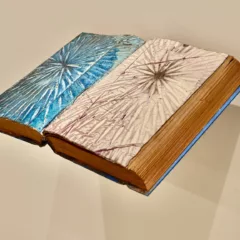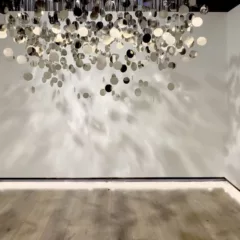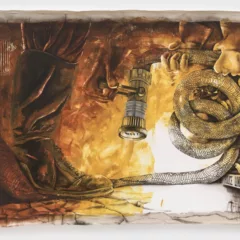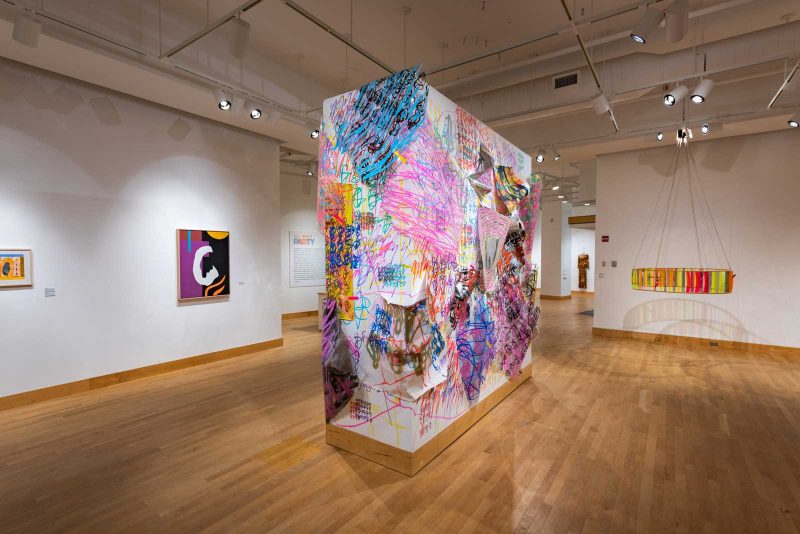
“People are trapped in history and history is trapped in them.” — James Baldwin from “Stranger in the Village.” 1953.
All Night Party began with the idea of celebration and gathering conceived by Erin Lehman after Professor of Costume Design in the Department of Theatre Arts, Julie Potter, lamented that there were so many fabulous party dresses from the 1920s in the Towson Historical Clothing Collection that were never seen by the public. Ultimately, we chose 10 garments from the 1920s—1980s to begin the core of an exhibition. We grew the exhibition to include relevant paintings, collages, sculpture, and installation by six artists: Dennis Beach (DE), Bobby Coleman (MD), Alex Ebstein (MD), Tim McFarlane (PA), Dominie Nash (Washington D.C.), and McKinley Wallace III (MD). A companion exhibition in our smaller gallery, “All Decked Out,” focusing on adornment, was co-curated by Susan Isaacs and Jewelry and Metalsmithing Lecturer/Coordinator, Luci Jockel and included the work of 21 artists from the US and abroad. We installed the exhibitions, but they could only be viewed in person by TU students, faculty, and staff. Consequently, we developed a rich online presence that would remain on view for a much longer period; it includes lectures, tours, interviews, studio visits, a podcast, and an original musical composition.
We chose artists for “All Night Party” whose works we felt resonated in some way with the past but were very much of the present, signaling Dada, early 20th-century modernism, Abstract Expressionism, Pop and Op Art, Minimalism, the Studio Craft Movement, graffiti, 80s street art, and installations, or revealed connections to protest murals and posters. We believed that the events of 2020 could be addressed through the dual lenses of art and history, even if the artists themselves did not always envision that context when making the work. Perhaps that is because we are both art historians who not only appreciate formal elements but who also yearn to establish historical and conceptual context for our exhibitions.
We wrote in our curatorial statement that:
We see the visual arts as a connecting thread between the significant historical events of the 20th century . . . and the daily experience of the people who lived through these eras, and between these events and those of the present moment, including national pandemics that upend daily life in the form of flu or Covid, and the Civil Rights and the Black Power Movements whose actions, lessons, aesthetics, and messages inform and echo Black Lives Matter. From McCarthyism to the ultra-patriotism of 9/11, Jim Crow to mass incarceration, history continues to find innovative ways of repeating itself, reminding us both how far we have come, and how much we have left to accomplish.
To us, there is a relationship between the historical garments and the works in the show that creates a liminal experience, welcoming the viewer to find a personal connection between the clothing, the art of daily life, and the art in the gallery. The artists were all supportive of this approach. While we began organizing the exhibition two years in advance, by the time we installed it, the theme held poignant memories of a time when we could gather for parties, so we instead “gathered” work in the gallery to celebrate the vision of each artist.
Dennis Beach (Schmidt Dean Gallery) creates sculptures and paintings that are carefully crafted with intense colors. He cuts and molds wood and sometimes employs plastic in his sculptures, resulting in dynamic forms that explode with color while demonstrating minimalist exactitude. He knowingly engages with the vocabulary of Modernism, including Pop, Op, and Minimalism. The results are sincere objects of beauty that demonstrate a meticulous hand but which also playfully nod to post WWII art styles. A tour of his studio, available on the exhibition website, offers a behind-the-scenes glimpse of his practice.
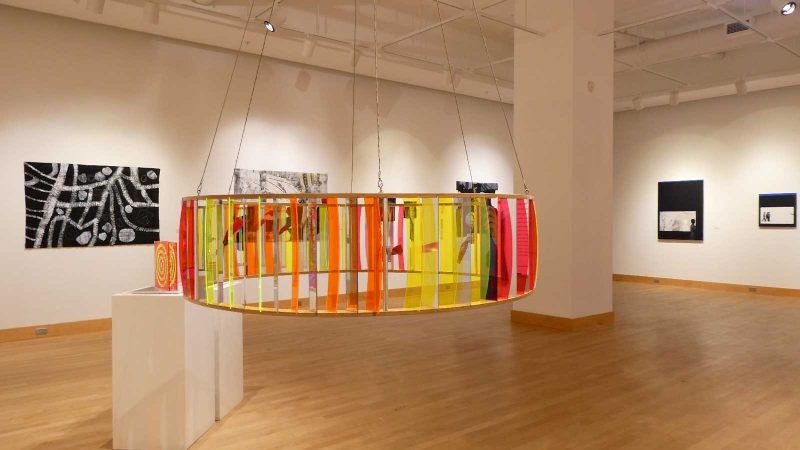
Though quite differently from Beach, Alex Ebstein (Resort Gallery) utilizes the images of modernism to invent something new. Her works demonstrate familiarity with iconic images by such artists as Arp, Matisse, and Rothko, but she reformulates their vocabulary. In a delightful tour de force, she does this largely by piecing together sections cut from yoga mats. Her works are colorful biomorphic abstractions that reference the body, and through them Ebstein addresses formal concerns of weight, balance, and space that interrogate human relationships to the world beyond the edges of the artwork.
Bobby Coleman is a painter and mark maker. In his work, he considers the textures, colors, architecture, history, sounds, graffiti, and general commotion that make up urban life, and deconstructs these objects and symbols, layering each mark onto its predecessor, resulting in complex compositions of interconnected thoughts and ordered chaos. In his recent installation work, which remains focused on painting, he extends his evolutionary, process-oriented method, done without preliminary sketches, with the result a familiar yet fresh visual vocabulary. An interview with Coleman about his creative process is available on the website.
An artist well known to Philadelphia audiences, Tim McFarlane (Bridgette Mayer Gallery), created an installation specifically for “All Night Party.” He also provided a two-part illustrated lecture which is available on the website. McFarlane is an observant chronicler of the contemporary environment, presenting multilayered images and materials that suggest graffiti and other debris from his surroundings; he lives in the city, and the impact of the construction sites, painted, layered, and pealing paint of old buildings that he walks by every day is revealed in this installation. Memory plays a role in his practice, where he brings together past and present and private and public space. He utilizes chance and improvisation to invent and reinvent unique installations, drawings, and paintings. Gestural marks and brushstrokes overlap and engage with the space.
Dominie Nash discovered textile art in the late 1960s and has been working as a full-time artist for over 20 years. Her collages emerged out of the Studio Craft tradition. She utilizes many different techniques to create her images, which are essentially paintings. These include immersion dyeing, painting with dyes and pigments, screen, mono, and Inko-printing, chemical resist, discharge, appliqué, and embroidery. The works are generally abstract compositions with organic forms and gestural marks that have a spontaneous quality, having long departed from traditional, functional quilts. Some of the smaller textiles include purposefully inelegant stitching that provides an immediacy and connect to works by other artists in the gallery.
Painter, draftsman, and educator McKinley Wallace III creates illustrative mixed-media work that celebrates the power of people to resist erasure and challenge dominant narratives through an exploration of race, history, and intersectionality. In a graphic style that incorporates elements of Minimalism, hard-edge painting, and documentary photography, his work focuses attention on real historical and contemporary bodies and faces. The paintings constitute archaeological explorations that uncover the forgotten pieces of both personal and cultural histories. They address humanity’s aggression and confront the history and continued manifestations of racism, segregation, loss, and most salient, the power and beauty of defiance.
All Night Party. Center for the Arts Gallery, Towson University, Co-curated by Erin Lehman, Director and Susan Isaacs, Curator of the Department of Art + Design, Art History, Art Education Galleries, Towson University, MD. On view online through June 30, 2021
All Decked Out, Holtzman MFA Gallery, Towson University. Co-curated by Susan Isaacs, Curator of the Department of Art + Design, Art History, Art Education Galleries and Metalsmithing Lecturer/Coordinator, Luci Jockel, Towson University, MD. On view online through June 30, 2021
These exhibitions are supported in part by the Baltimore County Commission on Arts and Sciences, the Maryland State Arts Council, and Towson University.
Author Bios
Erin Lehman is Director of the Center for the Arts and Holtzman MFA Galleries and Lecturer in Art History at Towson University in Maryland. She received her BA from Haverford College and her PhD from Tyler School of Art at Temple University. Her areas of research interest and teaching include the confluence of Impressionism, the professionalization of sports, and changing ideals of masculinity in the nineteenth-century, museum studies, social protest art of the 1960s, history of photography, and gender studies. Before coming to Towson, Dr. Lehman was a curatorial research associate at the American Philosophical Society Museum and a Curatorial Fellow at the Philadelphia Museum of Art. Recently curated exhibitions at Towson include “From the Inside Out: Building the Silhouette,” “All-Night Party,” and “Stacy Levy: Collected Watershed.”
J. Susan Isaacs is Curator of the Center for the Arts and Holtzman MFA Galleries and Professor of Art History at Towson University in Maryland. She received a Certificate of Fine Arts from the Pennsylvania Academy of the Fine Arts, and BA, MA, and PhD from the University of Delaware. Her areas of research and teaching include issues of race and gender in modern and contemporary art, museum studies, and art, politics, and society. Recently curated exhibitions include “All Night Party,” “Transcendence: Dorit Feldman | Rachel Rotenberg,” and “Constance Cone: Flanders Fields │ 25 years of Depicting British Trench Poetry.”


